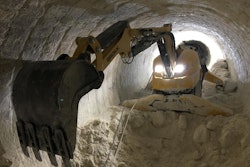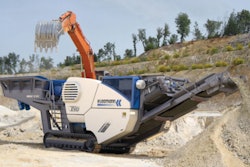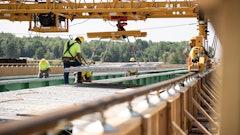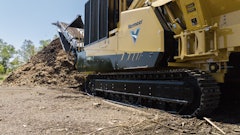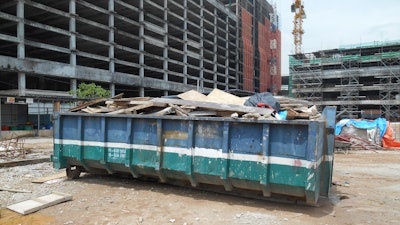
As any construction professional knows, even with significant recycling efforts, dumpster-loads of landfill waste can be generated by a site daily. According to a study by the Environmental Protection Agency in 2018, the United States produced an estimated 600 million tons of construction and demolition debris. Unfortunately, this staggering number continues to rise and could reach 2.2 billion tons by 2025. Spiraling landfill volumes will drive up disposal costs if considerable action is not taken. It’s critical for construction contractors and project participants to take on this challenge by better managing these risks and moving the industry toward a sustainable future.
While construction companies keep up with demand in response to the hot housing market and frenzied projects, let’s look at the waste issues at hand and tangible solutions that can help businesses maintain economic neutrality.
Dose of Construction and Demolition Waste Reality
The construction industry erects and demolishes hundreds upon hundreds of new buildings and homes every day. Although many of these structures contain non-renewable resources and materials that can be easily recycled or reused, most become victims of dumpsters and landfills. In fact, the average commercial building demolition brings about 155 pounds per square foot. So, if you were to turn a 50,000 square foot building into a demolition project, it would produce nearly 4,000 tons of waste.
It may, at first blush, seem more accessible and cheaper for construction companies to dump used or unwanted materials into landfills. However, this waste has a significant impact on the environment and our health, releasing toxins into the ground and our water supply when not handled or disposed of properly. Additionally, when contractors tear down or build structures, wind can carry loose debris, leaving it to settle nearby. Depending on the debris’ contents, it could create severe concerns for our public health.
What Items Can the Industry Recycle?
Fortunately, most construction materials can be recycled or repurposed. Here are a few valuable commodities that can have lives beyond their original purpose:
● Concrete and asphalt can be turned into aggregate or new cement products
● Old or unused wood can be used to create furniture, mulch or compost
● Metals like steel, brass and copper can be crushed and compacted to make new metal products
● Cardboard packaging that’s used to house various construction products can also be recycled
Knowledge and Planning Can Spur Change
In many cases, contractors and project managers can pave the way for a more sustainable future by reducing and eliminating on-site waste through careful organization and planning methods. The key to a cleaner and safer worksite is regular inventory checks and reporting. Whether you partner with an expert waste consulting and management service or keep tabs on the inputs and outputs yourself, conducting a routine analysis of your operations and the waste they produce can help assess how tighter waste management might improve your profit margins.
While sites can reduce waste and save upfront with careful inventory management, they can also save on the back end. Recycling can appear more costly than landfills due to the limited facilities and the technology involved in sorting and processing. But there are many factors to keep in mind when it comes to the cost equation. Here are few examples:
● How material prices fluctuate based on the economy - If oil prices rise, so does the price of the materials due to the fuel required to pick up and transport them. In times of lower oil prices, transporting recyclables can be more affordable.
● How easily the items can be transported - Cardboard and some metals can be compacted to better fit on trucks before heading to a processing location.
● How the materials are processed - Concrete, steel and glass can be cheaper to recycle because they require less processing and can be recycled repeatedly without losing quality. On the other hand, paper and plastic may run higher in cost because they need special processing, such as removing ink.
But no matter what, when you recycle, the costs necessary to transport and process materials support new materials that don’t have to be scrubbed from the Earth. Construction companies, especially during demolition, can receive a rebate for their recycled waste, making it less costly than sending it to a landfill.
With a well-run program, you can generate revenue and help offset the cost. When the market is profitable for an item, recyclers may lower the service fees for recycling. For instance, cardboard and metal are the materials with arguably the greatest commodity value. Having visibility on reporting and the prices of recyclables could ultimately effectuate a hopeful outcome for recycling that’s more widespread, like government support and a changed public mindset.
How to Build a Sustainable Foundation
Cost is the most significant driver of change. Although technological advancements in recycling are important, site management and planning during construction projects are critical. Through proactive planning and routine operations analysis, project managers can avoid buying excess materials or throwing away valuable items while identifying cost-effective nearby recycling sites.
Ultimately, to have a long-term impact, we must have reduced recycling costs, better material segregation, one-stop facilities, and state and owner requirements for landfill diversion. But, to get there, needle-moving efforts need to be made by the construction industry. We need to identify areas for improvement through reporting, enact changes for positive impact, quantify the effect, make modifications and share new knowledge.
Don’t let today’s economic paradigms stop you from performing a thorough assessment of your waste needs. You may uncover some surprises on ways you can take small steps forward in increasing recycling and improving the health and safety at your sites. We all need to be invested in the process to achieve our industry's overall environmental and recycling goals.




